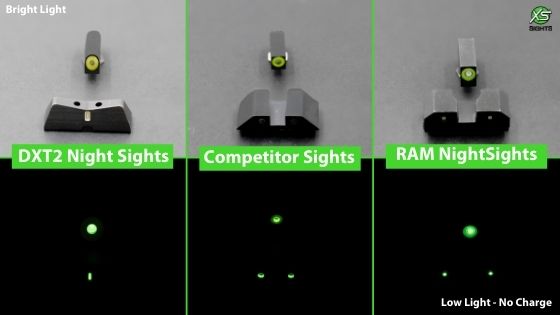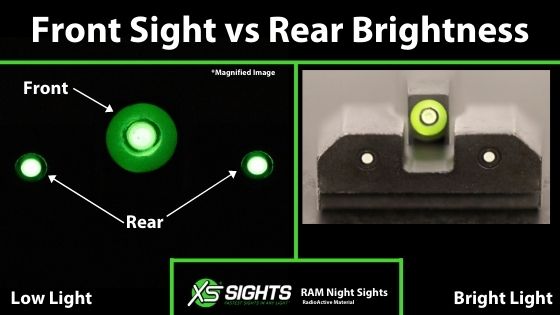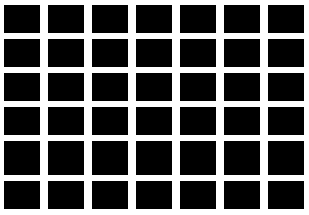What makes a good set of defensive tritium night sights?
Posted by XS Sights on Feb 17th 2021
The iron sight market is divided into two main categories – target shooting and defensive shooting. Though we at XS, love competitive shooting and participate in many pro-level matches, we have dedicated our business to manufacturing personal defense sights.
Target shooting utilizes a front sight with a thin blade, either blacked out or with a high-contrast, fiber-optic rod. The rear is blacked out and has a tight notch allowing for specific precision shots. Some rear sights will allow for height and windage adjustments.
Defensive sights should utilize a wide front blade, tritium lamp, and a colored ring of some sort for faster front sight identification. The rear notch width should be wider than the front, have anti-glare, and snag-resistant features. Defensive iron sights are fixed, adjustability is nice, but more moving parts means more things can go wrong (especially when dropped on concrete from 4-feet).

Front Sight Focus
We train to focus on the front sight; it's a standard phrase in any basic pistol course. When shooting on a static range, at paper targets for tight groupings, the front sight size doesn't matter much. However, front sight size DOES matter in a gunfight. Lighting is rarely optimal, fight or flight has kicked in, tunnel vision has you focused on the threat, and you must make critical decisions in seconds.With these critical factors competing for attention, small front sights can seem to disappear. In these unique, stress-filled situations, bigger is better.
While most training happens on a brightly lit range, there’s no telling what lighting condition will be present in any given gunfight. FBI statistics show that many do happen in low, or less than ideal light. Therefore, the front sight needs to be as bright as possible and visible in all lighting conditions. Defensive night sights need tritium for mid-to low-light levels and a high-contrast colored ring in the front sight for bright light settings. XS sights utilize Ember Glow Dots, which provide a photoluminescent glow, by absorbing ambient light from the surrounding environment and the light emission from the tritium. Ember, combined with tritium, ensures your front sight is always glowing brighter than the rear. XS's DXT2, F8, and R3D Night Sight product lines feature Ember/Tritium front sight.
Defensive night sights should have smaller and dimmer tritium lamps in the rear sight to ensure the front stands out more. The front sight is the most important piece of the sight system, as it represents the muzzle index of the firearm. Dimmer lamps are used in the rear is because of depth perception in low light, and to prevent confusing lamps of equal brightness (the front sight). In low light, the cones in our eyes are very sensitive to light and are not good at focusing on fine details. This is especially true during an adrenaline rush situation, everything will be blurry because the defender is threat-focused. Defensive night sights have a simple sight picture, drive focus to the front sight, and ensure the front sight is the brightest part of the sighting system.

Rear Sight – Keep it Simple Stupid
Rear sights need to be kept as simple as possible to drive focus downrange and increase the speed of sight alignment for precision shooting when time allows. XS product families include express sights, which use a v-notch rear sight to provide an unobstructed view of the front sight and our notch and post systems use a rear notch that is 15% wider than the front post plus added sight radius from the slide length. Both systems allow more visible light around the front sight edges making the alignment easier in low light levels or when shooting and moving. A simple example to demonstrate tight notch widths vs. wide notches is below.
Human eyes need light to be able to see; they adjust quickly in bright light and slowly in dark light. In low light, eyes lose the ability to make out fine details and have difficulty adjusting to changing lighting conditions. Imagine walking into a building after being out in the bright sunlight. When entering the room, everything will appear black and blurry. Depending on the person this effect can last for a short time or a few minutes.
Edges of notch and post sights become blurry if they are too close together. This effect becomes more noticeable in low and changing light levels. Here are a few images to test how your eyes work in low light when focusing on small details.
Look at one fixed point on the square below for 10 seconds.

Notice that your eyes see gray/black circles in the intersections.
Now, look anywhere on the square below for 10 seconds.


Notice the gray/black circles in the intersections are less prominent. Wider sight gaps ease the stress on the eyes. This will not eliminate the blurring, but it will slow it down in decreasing light levels.
Another important aspect of defensive rear sight design is anti-glare features. Many manufacturers use serrations, as this reduces the amount of surface area that can reflect light back to you. This feature also adds detail to the rear sight, which can result in pulling the eye’s focus back instead of forward to the front. Many of XS’ rear sights overhang back towards the rear of the firearm. This overhang changes the angle of the light refraction, reducing glare while keeping the rear sight simple.
So, when picking out defensive tritium night sights remember these 3 things. First, be sure to focus on the front sight. Second, keep things simple in the rear, and third be sure to pick out a set that will give you the confidence you need to make a great shot. At XS, we make excellent sighting solutions to perform in any light! Be among those with the XS advantage. Shop for yours today at xssights.com.
About the Author
XS Sights manufactures the fastest sights in any light. From concept and design to creation, XS utilizes tritium, photoluminescent materials, and 20+ years of sight manufacturing expertise to create highly visible and durable sights for personal defense, military, and hunting applications. Proudly made in U.S.A.

